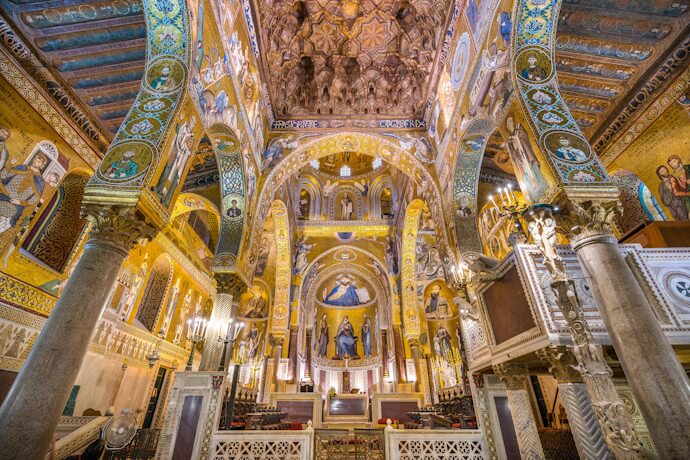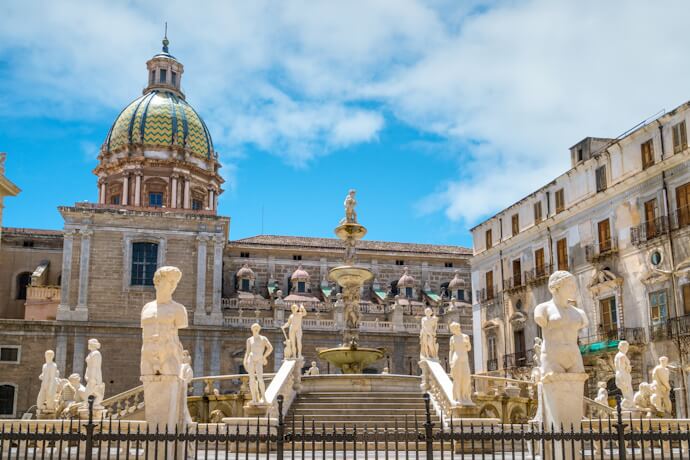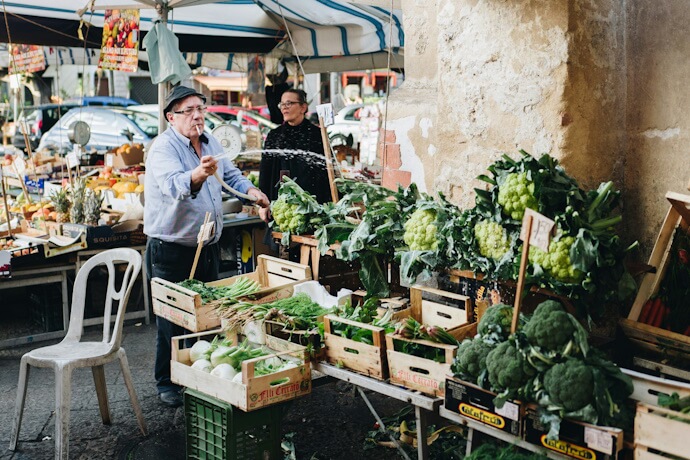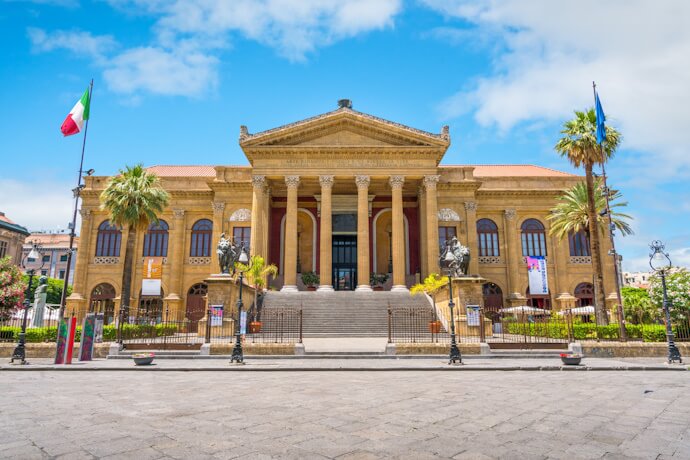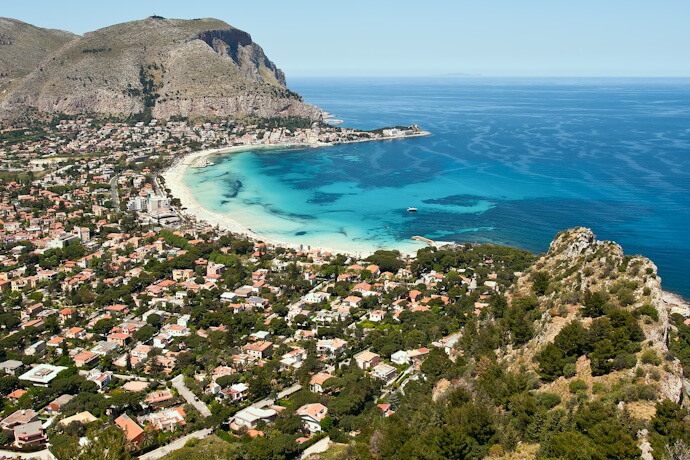Today’s journey will take you to Palermo, the vibrant capital of Sicily, with a unique blend of gastronomic richness, architectural beauty and historical diversity. From its notable street markets to its grandiose landmarks, Palermo is a treasure trove for those seeking an authentic and multifaceted Sicilian experience.
Here you will find numerous Norman-Arab structures that showcase the city's historical complexity and fusion of architectural styles, such as the wondrous Palazzo dei Normanni and the Arab-Norman Cathedral, both UNESCO World Heritage sites. In-between monuments, a memorable gastronomic experience awaits you beyond the confines of a restaurant. This city has a legendary street food scene that will leave you in awe.
Pack your bags and embark on a fun trip that will immerse you in the splendour of Sicily's past, with remarkable monuments and flavours in the mix!
1. Visit Palazzo dei Normanni & Cappela Palatina
You can start your adventure in Palermo with the Palazzo dei Normanni and Cappella Palatina, which will give you a glimpse into the rich cultural heritage of the region. The Palazzo dei Normanni (Norman Palace), is a historic palace that has served various rulers over the centuries. Originally built by the Arabs in the 9th century, it became the seat of power for the Norman kings in the 11th century. The palace has undergone numerous transformations, incorporating Arab, Norman, Gothic, Renaissance and Baroque architectural styles, making it a testament to Sicily's diverse cultural influences. Inside, browse through the opulent royal apartments adorned with intricate mosaics, stunning frescoes and period furniture.
Connected to the Palazzo dei Normanni is the Cappella Palatina (Palatine Chapel), a masterpiece of Arab-Norman art and architecture that is a must-see. Admire the intricate wooden ceilings, a work of art of Islamic craftsmanship known as muqarnas. The interlacing geometric patterns create a visually stunning and unique atmosphere. The horseshoe arches also exemplify its strong Arab influence.
The mosaics in this chapel are awe-inspiring. The scenes from the Old and New Testaments are depicted with exquisite detail and bright colours. The mosaic of Christ Pantocrator in the apse is particularly noteworthy.
2. Admire Fontana Pretoria
The Fontana Pretoria, also known as the Praetorian Fountain, is an impressive fountain located in the city's central square, Piazza Pretoria. But this fountain has travelled quite a lot. It was originally built in Florence by Francesco Camilliani in the 16th century; however, it was later acquired by the city of Palermo in 1574 as a gift from the Grand Duke of Tuscany, Cosimo II de' Medici. The fountain was then dismantled, transported to Palermo, and reassembled where it is today in 1581.
The Mannerist and Renaissance art styles are very visible in this fountain, characterized by a series of concentric rings adorned with classical sculptures and mythological figures, including gods, goddesses, nymphs and mythical creatures. The central basin features sculptures depicting various episodes from Greek and Roman mythology, such as the abduction of Persephone by Pluto and the Battle of the Titans. But these sculptures are also considered somewhat provocative, which gives this fountain the nickname of "Fountain of Shame" (Fontana della Vergogna).
Be sure to stroll around Piazza Pretoria, a lively square where locals gather, and observe Fontana Pretoria from different angles!
3. Experience Mercato del Capo
Steeped in history and surrounded by the narrow streets of Palermo is Mercato del Capo, a sensory delight that offers tourists a glimpse into the authentic daily life of locals while showcasing the typical flavours and colours of Sicilian culture. Its name "Capo" is derived from the Latin word "caput", meaning head or top, as the market is situated at the head or top of Via Vittorio Emanuele.
In terms of food, this market has everything you may need, starting with a cornucopia of fresh fruits, vegetables and herbs, showcasing the bounty of Sicily's fertile lands. Colourful displays of oranges, lemons, tomatoes and many other seasonal produce fill the stalls. Given Palermo's coastal location, seafood and fish are another highlight of the Mercato del Capo. If you are a meat lover, there are butcher shops available as well, selling traditional Sicilian meats, including sausages, cured meats and local specialties.
But a visit to Mercato del Capo goes beyond its food. The atmosphere is a fun blend of chaos and charm, with the energetic buzz of vendors and loud banter of visitors. A truly authentic experience!
4. Indulge in the local street food
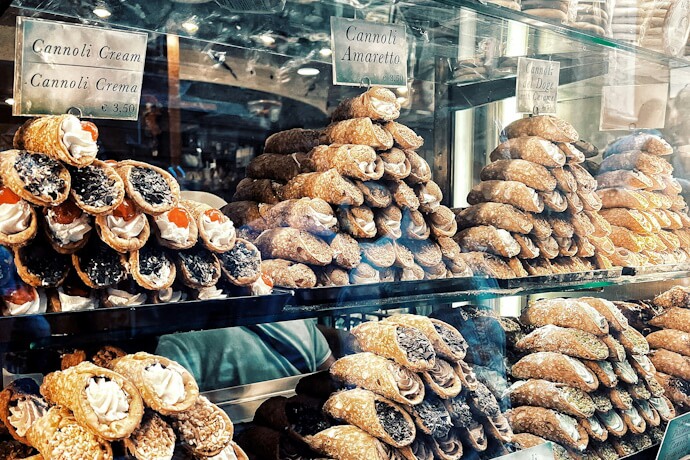
Palermo is renowned for its rich and diverse street food scene, offering a tantalizing array of flavours that reflect the city's cultural melting pot. Besides being a unique and delectable experience, street food really comes in handy when you have a sudden need to recharge your batteries during an eventful day.
One of the most popular Sicilian delights is Arancini, deep-fried rice balls, typically stuffed with ragù (meat sauce), peas and mozzarella. If you wish to try a new version of pizza, look for Sfincione. It is a traditional Sicilian pizza that differs from its Neapolitan counterpart known for its thick, spongy crust topped with a rich tomato sauce, onions, breadcrumbs and a drizzle of olive oil. Another great choice is Cannoli, iconic Sicilian pastries consisting of fried pastry tubes filled with sweet ricotta cheese. They are often garnished with candied fruit, chocolate chips or pistachios.
The best places to find these delicacies are the Mercato del Capo mentioned above, the Mercato Ballarò and central places including Piazza San Domenico and Via Maqueda.
5. Discover Palermo Cathedral
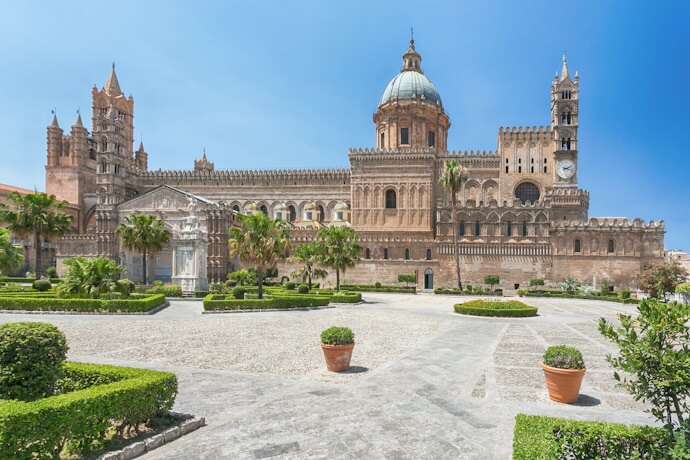
The Palermo Cathedral, also known as the Cathedral of Santa Vergine Maria Assunta, stands as a magnificent testament to the rich history and diverse cultural influences that have shaped the city of Palermo. Its construction began in the late 12th century during the Norman rule of Sicily and was built on the site of an earlier Byzantine church and an Arab mosque, showcasing the layers of cultural and religious history that characterize the city. The cathedral exhibits a fascinating blend of architectural styles, reflecting the diverse influences of the Normans, Arabs and later, the Swabians. The exterior displays a mix of Romanesque and Gothic elements, while the interior features intricate details inspired by Byzantine and Islamic art. Be sure to check out the chapels dedicated to various saints, each adorned with frescoes, mosaics and sculptures. The Chapel of Saint Rosalia, the patron saint of Palermo, is particularly noteworthy.
This cathedral is also the final resting place of several Norman kings and emperors, including Roger II and Frederick II. The royal tombs are an essential part of the cathedral's historical significance.
6. Immerse yourself in cultural life at Teatro Massimo
Teatro Massimo is an iconic symbol of the city and a cultural hub that highly contributes to the vigorous artistic scene in Palermo. It is also one of the largest and most renowned opera houses in Europe and deserves your undivided attention.
This architectural marvel was built in the late 19th century, during a period of economic prosperity in Palermo. Its construction began in 1875, under the direction of the architect Giovan Battista Filippo Basile. However, due to various challenges, including the death of Basile, the theatre was uncompleted until 1897. Teatro Massimo follows primarily a Neoclassical style, with elements of the Renaissance and Baroque. The exterior is adorned with Corinthian columns, statues and a monumental staircase, while the interior boasts a grand auditorium with ornate decorations and a prominent central chandelier, creating a luxurious and elegant atmosphere. If possible, go up to its rooftop terrace that allows you to appreciate both the historic cityscape and the architectural beauty of the theatre itself.
Teatro Massimo is mostly famous for its opera productions featuring world-class singers, conductors and orchestras. In addition to opera, the theatre hosts ballets, classical concerts and contemporary performances as well. Check the theatre’s calendar to see if you can attend one of its magical spectacles!
7. Marvel at San Giovanni degli Eremiti
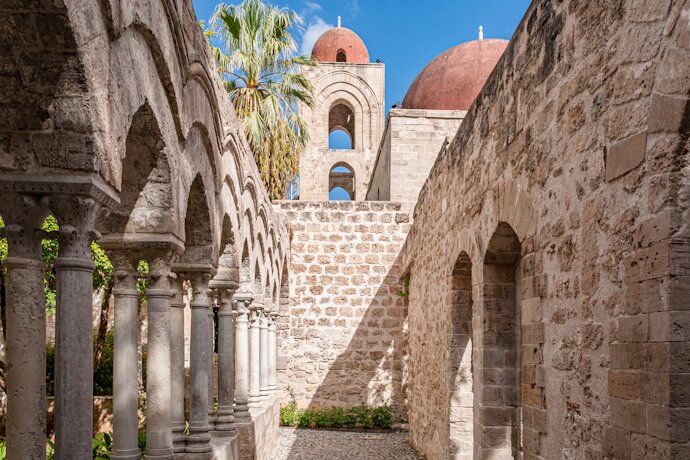
The San Giovanni degli Eremiti Church is a hidden gem that symbolizes Sicily's cultural diversity. Dedicated to Saint John the Hermit, it has ancient roots dating back to the Byzantine era. The original church on the site is believed to have been founded in the 6th century, although the current structure mostly reflects later Norman and Arab influences from the 12th century.
The most distinctive feature of San Giovanni degli Eremiti is its five striking red domes made of terracotta, which stand out against the blue Sicilian sky and add to the picturesque quality of the church. The surrounding green courtyard and cloisters contribute to a tranquil ambiance and an aesthetically pleasing environment.
Inside, you can find several Norman tombs that serve as a reminder of the church's connections to the Norman rulers of Sicily and the ability of different influences to come together into a harmonious and beautiful whole.
8. Go up Monte Pellegrino
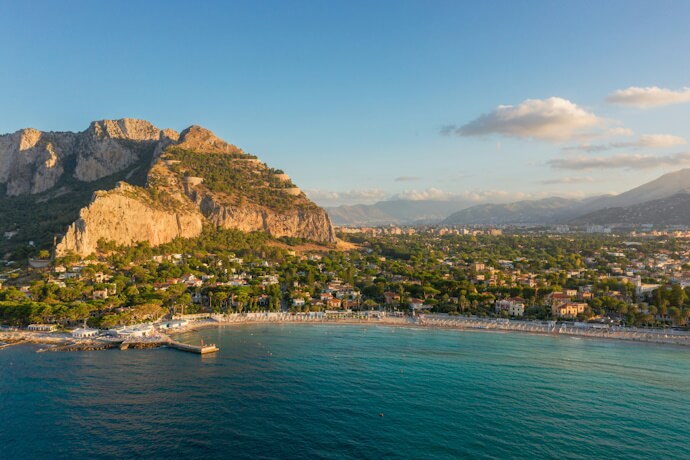
Monte Pellegrino is a limestone mountain popular for its stunning views of the Tyrrhenian Sea and the surrounding landscape. It is sought-after due to its historical, religious and cultural significance as well. For example, Monte Pellegrino has historical ties to various civilizations that have influenced Sicily and was considered sacred by the Greeks and Romans.
At the summit of Monte Pellegrino lies the Sanctuary of Santa Rosalia, a revered pilgrimage site that attracts devotees who come to pay homage to the saint. Santa Rosalia, a hermit who lived on Monte Pellegrino in the 17th century, is the patron saint of Palermo and legend has it that she took refuge in a cave in this mountain, now the Cave of Santa Rosalia. It is an essential spot if you are interested in the saint's life and legacy.
Monte Pellegrino is more than just a mountain, it is a multifaceted destination that combines natural beauty, cultural heritage and religious significance. Whether you are seeking a peaceful retreat, a historical journey or an outdoor quest, Monte Pellegrino grants you with an adventure! Make sure you bring comfortable attire to climb to the sanctuary or to just explore the hiking trails.
9. Detour to Monreale
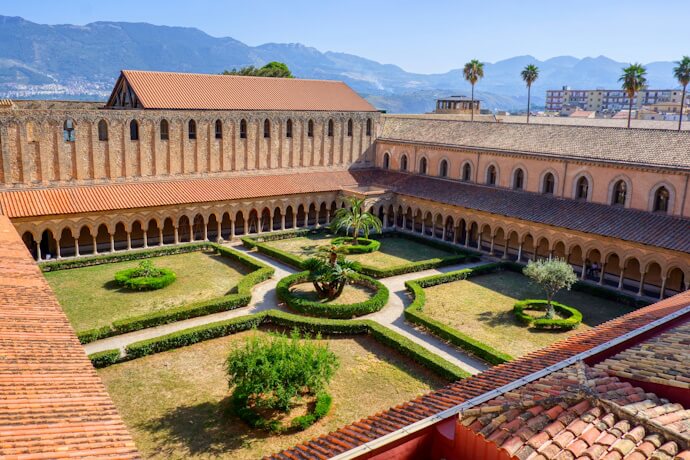
Monreale is a picturesque town known for its rich history and jaw-dropping views. Its highlight is the Cathedral of Santa Maria Nuova, a UNESCO World Heritage site. Built during the 12th century under the rule of William II of Sicily, it beautifully blends Norman, Arab and Byzantine influences. Its extensive mosaic decorations depicting biblical stories create a striking visual narrative that beckons visitors worldwide.
Beyond the cathedral, Monreale's narrow streets and historic buildings exude a charming atmosphere. The town retains a sense of authenticity, providing a delightful contrast to the bustling city of Palermo.
For breathtaking panoramic views of the Conca d'Oro (Golden Shell), the city of Palermo and the Tyrrhenian Sea, visit the Belvedere di Monreale. This vantage point provides a spectacular backdrop for capturing the beauty of the landscape.
In terms of transportation, Monreale is easily accessible from Palermo by bus. The journey takes approximately 30 minutes. If you prefer flexibility in your schedule, consider renting a car to explore this town and the surrounding areas at your own pace.
10. Relax at Spiaggia di Mondello
Spiaggia di Mondello is a beautiful beach located in the Mondello district near Palermo that offers an escape with its fine golden sand and clear turquoise waters. Recently, it has become an idyllic destination for those seeking relaxation, water activities and a pleasant beachside atmosphere. Surrounded by mountains and greenery, Spiaggia di Mondello’s astonishing backdrop enhances the overall beauty of the beach.
Take a stroll along the Mondello Promenade, known as "Via del Mare", which runs parallel to the beach. Lined with palm trees and charming Art Nouveau-style villas, the promenade adds to the beach's allure.
Spiaggia di Mondello features historic Art Deco bathing establishments that contribute to its vintage charm. These unique structures, dating back to the early 20th century, have become iconic symbols of Mondello.
A Culinary and Historical Odyssey
Palermo's allure is characterized by more than just its gastronomic delights and architectural marvels – it also lies in the city's ability to weave a narrative that transcends centuries of history. It is a place where every street corner tells a story and every bite of food is a celebration of Sicilian identity. Visiting Palermo is an immersive journey into the heart of Sicily, a city that proudly wears its cultural diversity as a badge of honour.


